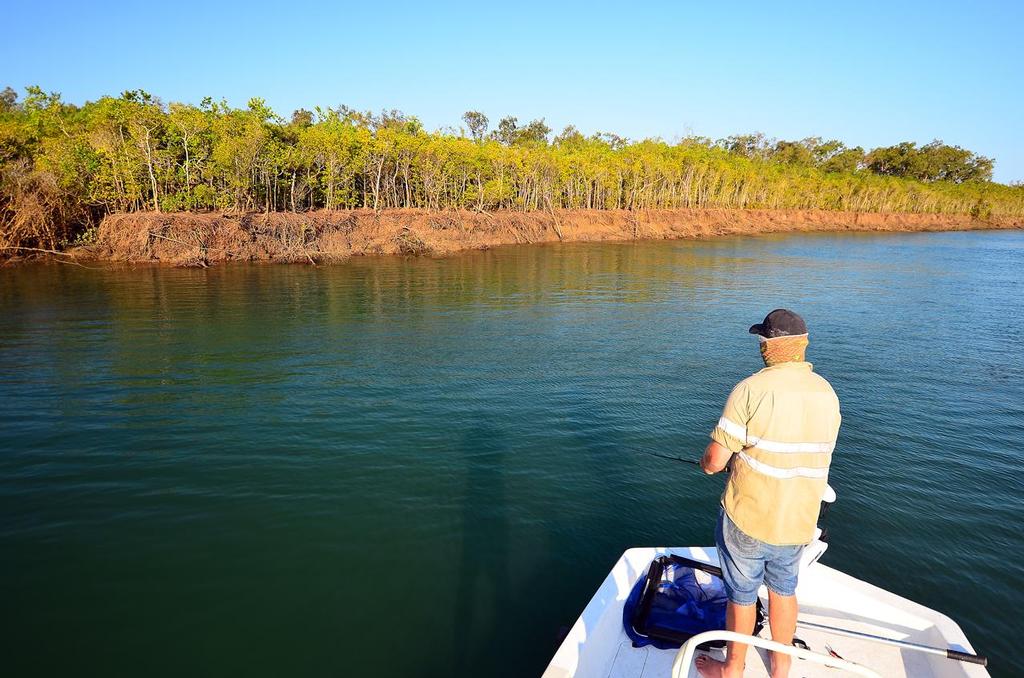High time and tide
by Lee Brake on 29 Sep 2013

Sam working part of the bank mentioned. Note how the bank is tall enough to prevent the high tide from entering the unfishable mangrove canopy. Lee Brake
This week Lee Brake talks about the age-old conundrum of 'time and tide' with regards to fishing a mangrove creek over the top of the tide period.
High tide has never been the ideal time for lure flicking in the estuaries; there's just too much water around! However, some creeks, by their very nature, are inaccessible over the bottom of the tide. These creeks usually have shallow mouths and no direct boat ramp access. This means that while getting locked in over the low tide is an option, many anglers prefer the freedom of visiting over the top of the tide. The question is – is it worth it?
It can be. The secret is all about observation and timing. In most cases, on high tides the root systems of the mangrove canopy surrounding the creek will be inundated. This means that bait and predatory fish like barra and jacks will push up into this labyrinth of roots, trunks and rhizomes well out of the casting range of anglers. What you, as an angler, are looking for are banks that are different. High banks where the water doesn't enter the mangroves, or at least where it leaves them quickly once the tide starts running out, are what you are mostly after. Such banks are usually made of different materials, rather than soft mud, and thus stand tall against erosion rather than constantly falling into the estuary and creating a gentle incline. This means that not only are their mangrove canopies drier over the high tide, they are also usually deeper banks.
Once you've found such a bank, it comes down to timing. And I don't just mean time of day – that's the easy part. I mean time and size of the tide. If the tide is too big, the bank is more likely to be submerged for longer and the current will really rip along a bank of this nature, often making it unfishable with lures. If the tide is too small (i.e. neap) then you're probably looking at the old adage of 'no run, no fun'.
I had an experience this week that perfectly typifies the above scenario. On Tuesday good mate Sam McCowan and I decided that we didn't want to head out too early so decided on a creek up the coast from Mackay that is just like the type mentioned above – shallow at the mouth and without a ramp. The high was a 4.5m at around 2.30pm and I wanted to fish the run-out, so we rocked up at 3.00pm. We quickly headed for a bank just like the type mentioned – this one was about a metre deep at its base but quickly dropped off a three metre ledge. The mangrove canopy was also well above the water line forcing a squillion herring to school up nervously around the edge of the bank, near the drop-off and around any piece of submerged timber.
We had a ball. The water was gin clear and there was just enough run to stir the fish into feeding. We literally saw over a dozen barra, a heap of trevally and some cod and flathead take our lures.
I even landed a 60cm grunter by working a handcrafted timber 'Fysshe' lure along the edge. One of the stand-out moments was working a little stick bait out of a drain coming off the bank. The drain's mouth was strewn with big snags and as my stick bait clip-clopped over one – BOOF! The drain exploded in a fury of white water and the barra had me cut off in the snags faster than my TV channel changes when Big Brother comes on.
However, the next day the old man rang me and, excited by my report, made plans for us to head to the same spot two days later. The high tide was just 4m by Thursday though and it was a notably neap tide. This made all the difference.
That metre deep base of the bank was now only half a metre deep and, combined with the insane visibility, this meant that any predators had retreated to the deeper water. The bait was still there, but the lack of water movement meant that it just milled around rather than get pushed past the snags and drain mouths were the predators waited in ambush. All up we only caught three fish (a barra, cod and flathead) and all of them came from the deeper water past the edge.
It was amazing the difference two days could make. The good news was that rather than be dejected, we analysed the reasons why one day fished better than the other and then headed home to mark out some better tides – between 4.5 - 5m highs – on the calendar.
Obviously different banks in different creeks will work on different tides, but by being observant to the reason why it worked or didn't, you can learn a lot as a angler.
Fish hard and stay safe.
If you want to link to this article then please use this URL: www.sail-world.com/115169